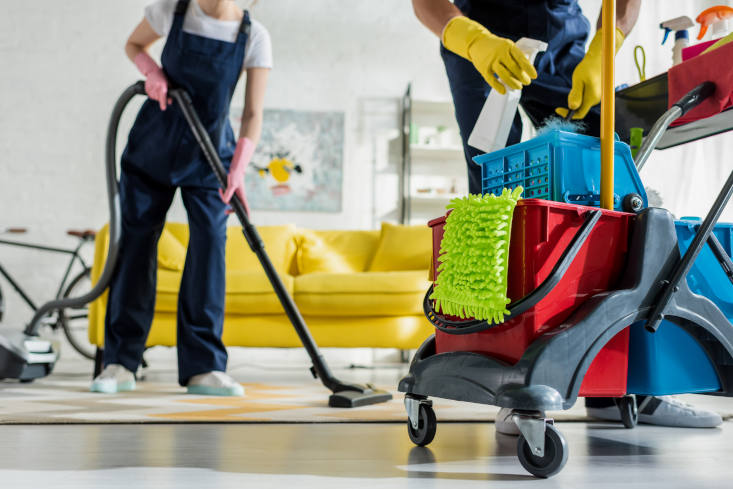The Best Guide to Everyday Cleaning: How to Scrub the Surfaces, Vacuum Carpets, and Clear Out Any Clutter
Understanding the Requirement for Extensively Disinfecting and Disinfecting Often Touched Surfaces in High-Traffic Areas
In the realm of public health and wellness and safety, the careful disinfection and sanitization of frequently touched surface areas in high-traffic locations stand as critical steps in stopping the spread of unsafe pathogens. By exploring the numerous elements of surface area disinfection, from the threats associated with neglecting cleansing methods to the efficient techniques that can be used, a more clear understanding emerges of the vital duty these techniques play in safeguarding public health.
Relevance of Surface Area Disinfection
Emphasizing the complete disinfection of high-traffic surface areas is critical in preserving a hygienic environment and preventing the spread of unsafe microorganisms. High-touch surfaces such as door manages, light buttons, elevator switches, and countertops work as reproducing grounds for infections and microorganisms. Routine disinfection of these surface areas is imperative to lower the threat of contamination and transmission of diseases.
By carrying out a robust sanitation protocol, establishments and companies can create a much safer environment for staff members, site visitors, and customers. Proper surface sanitation not just alleviates the spread of infectious diseases however additionally instills self-confidence in the cleanliness and safety of the facilities. This aggressive approach shows a dedication to wellness and wellness, which is particularly crucial in high-traffic areas where the possibility of direct exposure to microorganisms is enhanced.
Moreover, surface disinfection plays an essential function in general infection control techniques. Incorporated with hand health methods, using masks, and preserving physical distancing, detailed disinfection of high-touch surfaces forms an extensive defense against the transmission of unsafe microbes. Focusing on surface area disinfection is an essential part of an alternative approach to health and wellness and safety in shared spaces.
Risks of Ignoring Cleansing Practices
Ignoring extensive sanitation of high-traffic surface areas dramatically enhances the risk of viral and microbial contamination, posing a severe danger to the health and wellness of individuals often visiting these spaces. Failure to execute appropriate cleansing techniques can bring about the buildup and spread of unsafe pathogens, consisting of bacteria and infections, on frequently touched surfaces such as doorknobs, handrails, elevator switches, and counter tops.

In addition, neglecting the relevance of extensive cleaning not just compromises the health of individuals however also threatens efforts to keep a sanitary and tidy setting. It is crucial to acknowledge the importance of correct sanitation protocols in avoiding the spread of infections and safeguarding public wellness.
Effective Sanitation Techniques
To maintain optimum sanitation and decrease the danger of contamination on high-traffic surface areas, utilizing effective disinfection methods is crucial. Among the most usual and reliable disinfection techniques is making his response use of chemical disinfectants. These products can differ in toughness and composition, with some targeting certain pathogens like infections or microorganisms. It is important to adhere to the supplier's directions for correct dilution, contact time, and ventilation when utilizing chemical disinfectants to ensure their performance - Everyday cleaning.
An additional reliable technique is making use of UV-C light. UV-C light has been shown to be effective in killing a large selection of microbes by interrupting their DNA framework, therefore stopping them from reproducing. It is vital to use UV-C light properly, guaranteeing that the appropriate strength and exposure time are applied to attain the wanted disinfection results.
In addition, using heavy steam cleaning as a sanitation method can be very reliable, especially on surface areas that are heat-resistant. Steam can pass through porous surface areas and have a peek at these guys eliminate microorganisms, viruses, and various other microorganisms properly. When utilizing vapor cleaning, it is important to make certain that the surface area gets to the needed temperature for an adequate quantity of time to guarantee appropriate sanitation.
Effect On Public Health
The maintenance of high requirements of cleanliness and sanitation on high-traffic surfaces plays an essential duty in securing public health. Regularly touched surfaces in areas with high tramp, such as doorknobs, handrails, lift buttons, and bathroom centers, serve as breeding premises for damaging virus. Failing to appropriately disinfect these surfaces can bring about the quick spread of infectious illness within neighborhoods. By implementing complete disinfection protocols, the danger of transmission of infections, microorganisms, and various other germs can be considerably reduced.
In high-traffic areas like flight terminals, schools, hospitals, and public transportation systems, the influence of rigorous disinfection measures can not be underrated. Focusing on the sanitization of regularly touched surface areas is a proactive approach to promoting public wellness and improving the safety and security of individuals in common rooms.
Executing Regular Cleaning Procedures
Without delay setting up and adhering to a regular routine of cleaning methods is extremely important for keeping the tidiness and security of high-traffic surfaces. Regular cleansing methods are essential in avoiding the accumulation of bacteria and microorganisms on regularly touched surfaces, specifically in areas with high foot web traffic. By carrying out a methodical strategy to cleaning, companies can successfully lower the risk of illness transmission and develop a healthier environment for workers, clients, and the public.
To develop a reliable cleaning timetable, it is vital to determine high-traffic areas that need frequent focus. These areas may include doorknobs, handrails, elevator switches, washroom facilities, and common equipment. Applying a routine cleansing regimen that targets these surfaces multiple times a day can considerably decrease the spread of hazardous microorganisms and infections.
Moreover, utilizing appropriate cleansing representatives and disinfectants is key to guaranteeing that surfaces are navigate here completely sterilized. Regular training of cleaning staff on proper cleansing strategies and the value of adherence to the cleaning schedule is also vital in maintaining a sanitary setting. By prioritizing constant cleaning methods, companies can promote the health and wellness and health of individuals that connect with these high-traffic surfaces.

Final Thought
In final thought, it is essential to prioritize detailed sanitation and sanitization of regularly touched surfaces in high-traffic locations to stop the spread of damaging microorganisms and preserve public wellness. It is critical to acknowledge the significance of keeping tidy surfaces in high-traffic locations to make sure the well-being of the community.
In the realm of public wellness and safety and security, the careful disinfection and sanitization of regularly touched surface areas in high-traffic areas stand as paramount actions in stopping the spread of hazardous virus. By checking out the numerous aspects of surface sanitation, from the risks connected with neglecting cleansing methods to the effective techniques that can be employed, a clearer understanding arises of the important function these methods play in guarding public health and wellness.In addition, employing heavy steam cleaning as a disinfection method can be very effective, particularly on surface areas that are heat-resistant. When making use of steam cleaning, it is essential to make certain that the surface reaches the required temperature level for an enough quantity of time to assure proper disinfection.
In conclusion, it is critical to focus on complete sanitation and sanitization of often touched surface areas in high-traffic areas to prevent the spread of hazardous pathogens and preserve public health.